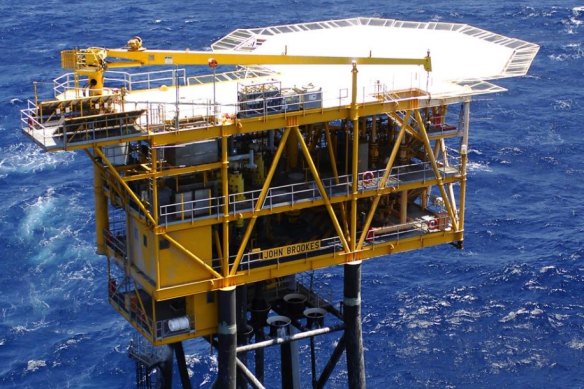Save articles for later
Add articles to your saved list and come back to them any time.
Small mistakes can have large consequences. Western Australia lost one-fifth of its gas supply a year ago, mainly because someone marked a few metal components in the wrong place two decades earlier.
On November 27, 2022, a helicopter landed a maintenance crew onto a Santos gas platform off the WA coast, and, shortly after, they saw gas bubbles rising to the ocean surface just 20 metres away.
Santos operates the John Brookes gas platform off the WA coast.Credit: Santos
It was not a good sign for the workers on the John Brookes platform, who were quickly evacuated. Santos then depressurised the 50-kilometre gas pipeline to Varanus Island to make it safer.
For more than 10 weeks, no gas flowed from the platform to a processing plant on the island that supplied the WA mainland.
Behind the scenes, gas producers and buyers scrambled to keep the economy of Australia’s most gas-dependent state going. It mostly worked, although Norwegian fertiliser giant Yara had to shut its plant on the Burrup Peninsula for a while.
However, in early January, when two more gas plants – Santos’ Devil Creek and Chevron’s Wheatstone – went down, the economic pain mounted.
Yara had more shutdowns, Alcoa cut output from its Kwinana alumina refinery, companies paid a fortune for alternative gas supplies, and those short of gas switched to even more expensive diesel.
What caused the mayhem?
The answer was revealed in a safety bulletin recently released by the offshore safety regulator NOPSEMA that diplomatically did not mention Santos or name the John Brookes platform.
A simple mistake in 2004 undid a costly solution designed to keep the pipeline safe for decades.
The gas and fluids flowing from the reservoir beneath the platform are hot and contain a high level of carbon dioxide: two contributors to rapid metal corrosion.
The pipeline’s first section – before the ocean cooled its contents – was to be lined on the inside with expensive corrosion-resistant alloys. This included the flanges, flat plates at the end of pipe lengths that allow them to be bolted together.
However, the project operator, US company Apache, also bought flanges made with normal steel for use elsewhere on the project.
Unfortunately, the identifying marks to tell which flange was which were placed where they were difficult to see, so normal flanges were used on the seabed near the John Brookes by mistake.
That error cost Santos, its customers, and other gas users tens of millions of dollars.
Later, opportunities to fix before the gas leaked the problem were missed.
Electronic sensors pushed through the pipeline detected the growing corrosion problem, but the inspection company’s employee thought the readings were an error and did not report them.
According to the safety bulletin, the corrosion could have resulted in a fire or an explosion.
Interruptions to gas supply from rusting pipelines can be a lawyer’s picnic, as Apache found out just three years after it installed the wrong flanges near the John Brookes platform.
In 2008, a gas pipeline on a Varanus Island beach exploded in a ball of flames, creating an 8-metre by 30-metre crater, and the heat soon made two other nearby pipelines explode.
The pipe wall had corroded from an original 11 millimetres thick to just 1.5 millimetres – too thin to contain the high-pressure gas.
WA lost 30 per cent of its gas supply for months and the total cost to the economy was estimated to be up to $3 billion.
The federal and state governments conducted an inquiry and Apache then launched a legal battle to suppress the report, probably to keep the information from its customers, including Alcoa, which was suing it for losses from the interrupted gas supply.
Santos, which took over the oil and gas operations around Varanus Island in 2018, will be hoping the lawyers stay out of it this time.
Start the day with a summary of the day’s most important and interesting stories, analysis and insights. Sign up for our Morning Edition newsletter.
Most Viewed in National
From our partners
Source: Read Full Article



